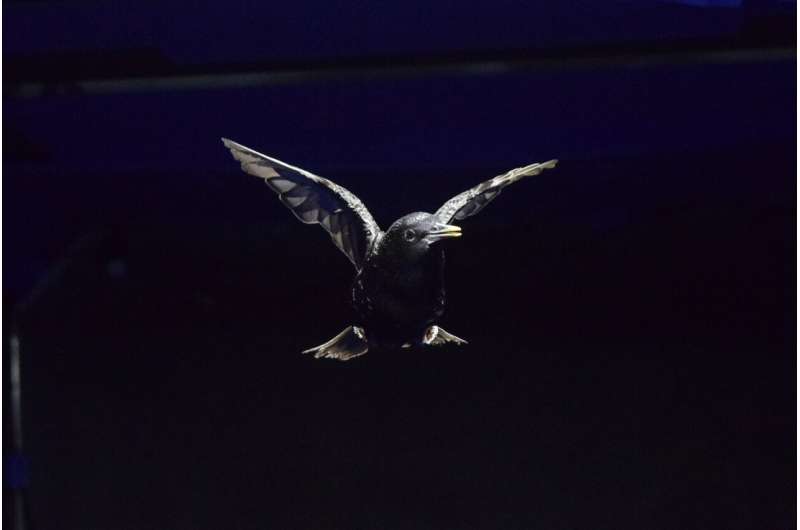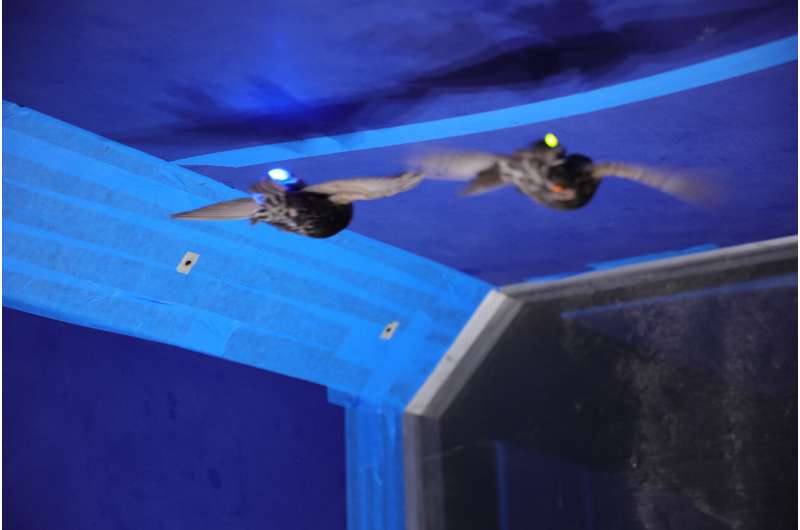June 18, 2024 report
Starlings found to expend 25% less energy in follower position compared to flying solo

Bob Yirka
news contributor

A multidisciplinary, multi-institutional team of researchers in the U.S. has found that starlings that fly in a follower position expend 25% less energy than when they fly solo. In their study, in the Proceedings of the National Academy of Sciences, the group designed complex experiments to learn more about the amount of energy savings for birds following another bird in flight rather than going it alone.
Prior research and logic suggest that if a bird were to fly behind another bird, it would use less energy because there would be less wind resistance. But testing the idea has proven difficult. In this new effort, the research team designed and carried out what they describe as "difficult" experiments to test energy expenditure by birds in flight.
The team chose starlings as the test birds and set about figuring out how to test their energy expenditure in flight.
They found a suitable wind tunnel at Brown University—it was large enough to allow three starlings to fly together in a natural flight pattern. The next step involved figuring out how to monitor the movement of the birds in flight. This was solved by developing tiny backpacks fitted with inertial measurement units (IMUs) and colored LEDs that were small enough not to disturb their natural flying characteristics.
The IMUs captured acceleration and angular velocity data—the LCDs allowed the researchers to keep track of which bird was which.
A third part of the experiment involved finding a way to measure how much energy the birds were using during a given flight test. This was solved by injecting them with sodium bicarbonate containing the non-radioactive isotope carbon-13.
By measuring the ratio of carbon-13 to carbon-12 both before and after a flight, the researchers could calculate how much energy had been expended.

The research team had to run many more trials with the birds than expected because of the number of things that could go wrong in a given trial, such as the birds choosing not to fly, or not choosing to fly behind another bird. They also found difficulty, in some cases, with measuring the data they received.
Eventually, the team carried out enough trials to provide sufficient data to show that one bird flying behind another in natural flight used 25% less energy on average. They also found that the birds that were the most naturally energy-efficient tended to adopt the leader role more readily and easily.
Written for you by our author —this article is the result of careful human work. We rely on readers like you to keep independent science journalism alive. If this reporting matters to you, please consider a (especially monthly). You'll get an ad-free account as a thank-you.
More information: Sonja I. Friman et al, It pays to follow the leader: Metabolic cost of flight is lower for trailing birds in small groups, Proceedings of the National Academy of Sciences (2024).
Journal information: Proceedings of the National Academy of Sciences
© 2024 Science X Network


















